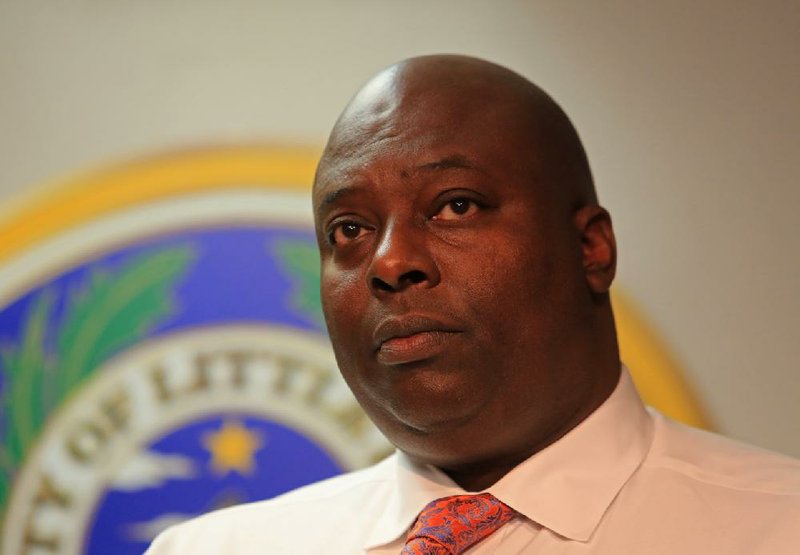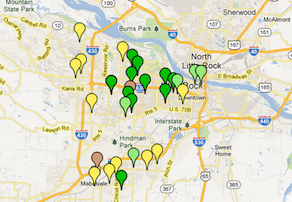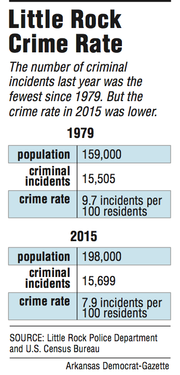Crime in Little Rock decreased a second straight year in 2015 as police recorded the fewest number of criminal incidents since 1979.
There were 15,699 criminal incidents last year, down 4.7 percent from 16,479 in 2014, according to police data. The statistics, released under the state's Freedom of Information Act, show the decrease was driven by fewer instances of burglary, petty theft and vehicle theft, property crimes that account for more than three-quarters of the city's crime annually.
A Democrat-Gazette analysis compared the number of criminal incidents to U.S. Census Bureau data and found the crime rate in 2015 was the lowest in at least 36 years.
In 1979, when police recorded 15,505 criminal incidents, there were 9.7 criminal incidents per 100 residents.
There were 7.9 criminal incidents per 100 residents last year.
"It's really tremendous, tremendous progress," Mayor Mark Stodola said. "I remember when I was prosecuting attorney back in 1993 and we had, I think, a high of 27,000 incidents. I'm very excited we've had this continuous decrease from year to year."
Despite the decrease, Little Rock's crime rate remained higher than other U.S. cities of similar size, including Akron, Ohio; Amarillo, Texas; Fayetteville, N.C.; and Columbus, Ga., according to the most recent data available in the FBI's annual Uniform Crime Report.
Little Rock Police Chief Kenton Buckner called the crime decrease last year, and the 5.8 percent decrease in crime reported in 2014, examples of "incremental success."
"Overall, I would say that Little Rock is a safe city," he said. "I think that you can do things to prevent yourself from being a victim of crime, but overall I think that we're a safe city with challenges like any other urban community across this country."
Buckner said one of those challenges is violent crime, which decreased in certain categories and surged in others last year.
There were 31 homicides in 2015, down from 44 the previous year and the lowest since 2010.
Police also reported a significant drop in robberies. There were 672 holdups last year, down from 756 in 2014. It was the lowest number of robberies since 2001, and about half of the historic high seen in 1991.
But the number of rapes reported last year, 163, was nearly 20 percent higher than the 136 rapes logged in 2014. It equaled the number of reported rapes in 2009, the most reported since 1997. The highest reported rape figures were seen in the late '80s and early '90s, when reports hovered above 200 for several years.
Aggravated assaults increased last year as well. There were 2,127 instances of aggravated assault, 61 percent more than in 2014. Last year's figure was the highest in nearly a decade, though it doesn't come close to the more than 4,000 instances recorded in both 1993 and 1994.
Arkansas law defines aggravated assault as "extreme indifference to the value of human life," shown through behavior that creates a substantial danger of death or serious physical injury. Threatening someone with a weapon is generally considered aggravated assault. It's a Class D felony.
Nationwide, crime has been on the decline since the early '90s. Buckner said various social and economic factors affect crime trends, but did not offer specific reasons for the ebb and flow of some offenses in the Arkansas capital.
"That's the million-dollar question, whether your crime is up or down," he said. "It's often difficult to make a true nexus to why you think that this activity led to this increase or decrease."
But when it comes to property crime, Buckner tied the decrease to the department's computer statistics, or CompSTAT, program. Police continuously track and map criminal offenses, and provide officers with weekly reports. That information, combined with other intelligence, allows police to strategize and manage resources more effectively.
Such data-driven police work has become widespread over the past two decades.
It's not new in Little Rock, but Buckner said it has improved.
"We're able to track trends a lot faster now," he said. "And because we can pick up on a trend, it allows us to put our resources in place at the location where we feel like we're having the issues, and then be able to key in on who we believe the problem individuals are in those geographic areas."
Property crime fell from 14,150 incidents in 2014 to 12,614 incidents last year, a decrease of more than 10 percent. Arson was the only property crime that increased. Police recorded 92 instances of arson last year, compared with 69 in 2014.
Buckner said increased communication with the public, particularly through social media, likely affected property crime figures, as well.
The department has about 15,000 followers on social media and has become significantly more active online, posting public safety alerts, images of wanted suspects and information on community events. Police had about 1,500 followers between its Facebook and Twitter profiles b̶e̶f̶o̶r̶e̶ ̶d̶e̶p̶a̶r̶t̶m̶e̶n̶t̶ ̶s̶p̶o̶k̶e̶s̶m̶e̶n̶ ̶L̶t̶.̶ ̶S̶t̶e̶v̶e̶ ̶M̶c̶C̶l̶a̶n̶a̶h̶a̶n̶ ̶a̶n̶d̶ ̶o̶f̶f̶i̶c̶e̶r̶ ̶R̶i̶c̶h̶a̶r̶d̶ ̶H̶i̶l̶g̶e̶m̶a̶n̶ ̶t̶o̶o̶k̶ ̶o̶v̶e̶r̶ ̶t̶h̶e̶ ̶a̶c̶c̶o̶u̶n̶t̶s̶ in June 2015. Little Rock police neighborhood watch and public affairs coordinator Victoria Brown oversees the department’s Twitter and Facebook accounts.*
The department hopes to eventually have 20 percent of the city -- roughly 39,600 people -- following its social media accounts.
"I think that when you're connected with the community, people are more likely to support you," Buckner said.
"People are more likely to get involved when they're educated about what's going on. It's a lot quicker for us to pick up warrant suspects when we're using 200,000 eyes and ears of the community to help you with public safety."
The department has sought help elsewhere in addressing violent crime.
In September, Little Rock police joined a federal program aimed at reducing violent crime in certain cities. The city was selected for the U.S. Department of Justice Violence Reduction Network along with West Memphis; Compton, Calif.; Flint, Mich., and Newark, N.J.
The two-year program doesn't provide money, but offers training, technical assistance and federal resources to participating cities. It also helps police develop strategies on fugitive apprehension, drug trafficking and gang intervention.
Buckner said reducing domestic assault, which accounts for the majority of assault cases in the city, is "probably the No. 1 thing we're trying to do" through the federal program. As a trial, the department has assigned an officer in its northwest division to check in with repeat victims of domestic assault, sometimes to relay court information and other times to simply offer support.
It may not be part of an officer's job description, Buckner said, but it could prevent future incidents.
"Is it something that we would like to be doing? No. But we just feel like if we could do more to get people out of this vicious cycle of violence, we have to do what we can," he said.
The personal nature of those crimes makes them difficult for police to address, Buckner said. The same applies to homicides, the majority of which, year after year, police classify as "domestic" or "victim known to suspect."
"We see very few homicides like that, where's there's no pre-existing relationship, where one person doesn't know anything about the other person," Buckner said.
Little Rock police had no explanation for the increase in rapes reported in 2015. Buckner suggested the rise of online dating may have been a factor, and there's evidence to support that theory.
A widely-reported study by the United Kingdom National Crime Agency this year found that between 2009 and 2015, reports of people raped on the first date after meeting someone online or through a cellphone app increased from 33 per year to 184.
Monie Johnson, executive director of the Arkansas Coalition Against Sexual Assault, said sexual predators have been known to use dating services, but that's probably not the sole reason behind the increase in rape reports in Little Rock.
"It could be one of the reasons that has been happening is because more people are feeling empowered to use their voices to talk about what happened to them," she said. "They may be reporting because they feel like they will be believed. When things like that happen, we would expect those numbers to go up."
Johnson noted that many cases of rape and sexual assault are never reported to law enforcement.
In thousands of other cases, evidence goes without testing. In February, the state Crime Lab reported finding 704 sexual assault kits in Arkansas that had not been submitted for testing -- that was in addition to the 1,513 untested sexual assault kits it already knew about.
Preliminary police data show violent crime, including rape, has continued rising in Little Rock through the first three months of 2016.
"You've got to be vigilant on this," Stodola said. "You've got to have this as your No. 1 focus every day. Obviously, public safety is our first and foremost obligation."
Metro on 04/11/2016
*CORRECTION: Little Rock police neighborhood watch and public affairs coordinator Victoria Brown oversees the department’s Twitter and Facebook accounts. This story incorrectly stated who manages the department’s social media activity.



